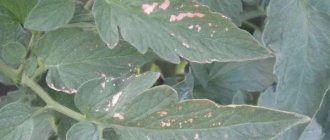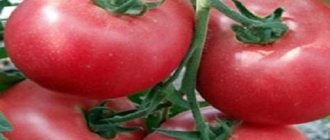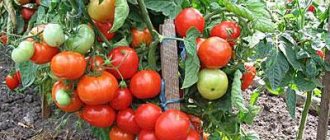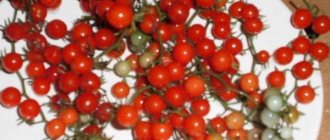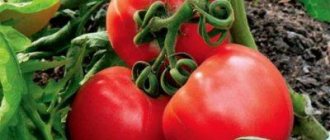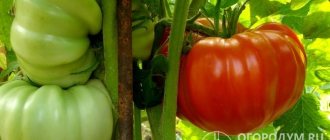Description of the variety
The Khokhloma tomato is a mid-season variety . The fruits begin to ripen 110–120 days after germination. The plant is tall, the bush reaches 2 m. The leaves are simple in shape, medium in size, green. The first flower appears above the eighth leaf, the rest appear after three leaves. Up to 15 fruits are formed on one cluster; after full ripening, they do not fall and hold tightly.
Important! Khokhloma tomatoes are mainly grown in greenhouse conditions, but they are also planted in open ground in southern regions with warm climates.
Distinctive features
The Khokhloma variety is distinguished by its unusual fruit shape (see photo). Elastic tomatoes tolerate transportation well and are stored for a long time. The crop produces a high-quality harvest and has strong immunity to most diseases.
Fruit characteristics, yield
Parameters of Khokhloma tomatoes:
- The fruits have an oblong shape, each about 17 cm in size. The tomato resembles a cylinder, the shell is smooth.
- The color of a ripe tomato is bright red.
- The weight of one vegetable is 110–120 g.
- Tomatoes have thick and dense skin, which is excellent for canning, pickling and transportation. The pulp is also dense, not watery.
- Subject to the rules of agricultural technology from 1 sq. m vegetable growers harvest up to 10 kg of crop.
Fruit characteristics
- The pods tie and sing at the same time.
- Unripe tomatoes are light green. The color of ripe tomatoes is bright red.
- The skin is smooth and dense.
- The flesh is dense and crispy.
- The shape is long, cylindrical. The fruits grow up to 1 2 cm in length.
- The average weight of 1 tomato is about 150 g.
- Inside there are 2-3 seed chambers, which contain an average number of seeds.
- Concentration of dry substances up to 4%.
- Has good keeping quality. According to reviews from gardeners, some managed to preserve fresh fruits until the New Year.
- It tolerates transportation well over long distances.
How to grow seedlings
The Khokhloma tomato variety is grown only by seedlings . To do this, seed material is sown in small containers with fertile soil. When the plants grow stronger at home, they are planted in a permanent place in open ground or a greenhouse.
Seed preparation
In retail sale there are tomato seeds in unprocessed form .
Before planting, such material is calibrated and disinfected. To do this, planting material is placed in a container with a saline solution (1 tablespoon of salt per liter of warm water) for 5 minutes. Empty unusable seeds will remain on the surface (they are disposed of), and those that settle to the bottom will sprout and yield. After rejection, suitable grains are washed under running water , wrapped in gauze and pickled in a 1% solution of potassium permanganate for 20–30 minutes, then rinsed again with clean water. This will kill fungal spores. Next, the seeds are laid out on a dampened cotton cloth and covered with it. The material is placed in a warm place and periodically moistened until the grains hatch.
Container and soil
These containers are used for growing seedlings:
- purchased containers with cells and a lid;
- peat cups or tablets;
- wooden boxes;
- cut plastic bottles or boxes of milk, juice;
- disposable cups.
At the time when the seeds hatch, they begin preparing the soil mixture . To prepare the soil, mix 1 part sand and 2 parts peat. To 10 liters of the resulting substrate add 1 liter of wood ash. The mixture is mixed well, after which it turns out to be excellent soil for seedlings.
About other varieties of tomatoes:
Tomato variety "Strawberry Tree"
A persistent hybrid from Japanese breeders - tomato "Michel f1"
Tomato “Visibly-invisibly”: setting yield records
Sowing
When growing tomatoes in greenhouse conditions, seeds for seedlings are planted in the second half of March .
If you plan to plant in unprotected soil, sowing the seeds is carried out in the first half of April. The container is filled ¾ of the volume with soil , which is slightly compacted and moistened. The grains are deepened into the soil 1 cm according to a 2 x 2 cm pattern and sprinkled with substrate on top. Then, before the shoots appear, the container is covered with transparent glass or covered with film and placed in a warm place.
Growing and care
Seedlings are kept at temperatures from +25 to +30 °C . The first shoots appear in about a week. At this time, remove the cover and place the container in a bright place, for example, on a windowsill. Within two weeks, the plants actively form roots, and then the above-ground part develops. During the growth of tomatoes, the daytime temperature is kept at +20 °C, and the nighttime temperature is reduced to +16 °C.
Seedlings need lighting 12–14 hours a day . If there is not enough daylight, fluorescent lamps are used. At the initial stage, plants are watered once a week. When the bushes have three true leaves, a pick is made. To do this, they are transplanted into separate containers with a volume of no more than 1.5 liters. The root system is deepened strictly vertically, to the cotyledon leaves, and if the plants are very elongated, then to the first true leaf.
7–10 days after picking, the tomatoes are fed for the first time with preparations for seedlings, for example, “Biohumus” or “Baikal EM1”. Fertilizers are prepared strictly according to the instructions indicated on the packaging.
Two weeks before planting the seedlings in a permanent place, the plants are hardened off . To do this, the bushes are taken outside or onto the balcony for 1-2 hours. The time spent by tomatoes in the fresh air is gradually increased.
Growing
It is better to grow tomatoes of this variety in a greenhouse, but since the bushes are quite tall, the structure itself must match. To form a bush and a garter, it is ideal to use a trellis net. To grow tomatoes you will need to do the following:
- Initially, the seedlings are prepared. For this purpose, treated seeds of the variety are used, which are sown in light, nutrient-rich soil. The seed depth is 2 cm. Before planting, the soil is well moistened.
- To get good seedlings and a future harvest, you need to constantly water the soil and fertilize it. An equally important factor will be temperature; if planting is done in cold weather, they simply will not sprout.
- After the first shoots, with the appearance of the first leaf, picking is done into a separate container. When the seedlings are 60 days old, they can be planted in open ground.
- Before planting in the garden, you need to prepare it. Initially, the soil is dug up and fertilized. Humus, ash or special complex fertilizers are suitable for feeding.
- If seedlings are planted in a greenhouse, then the ideal time for this is in April. If the planting is on an open plot of land, then the month of May is suitable. One of the important rules is heated soil, the temperature of which will be from 14 degrees.
- As reviews and photos of the Khokhloma tomato show, the maximum yield will be when the plant is formed into one stem. Small stepsons, less than 4 cm, need to be cleaned once a week.
- The garter of bushes is carried out on trellises.
- The bottom leaves are removed one at a time each day, which reduces unnecessary consumption of nutrients that are important for the ripening of tomatoes. In addition, it is the lower leaves that take bacteria and disease spores from the ground.
- During cultivation, the soil is constantly loosened, fertilized, and weeded.
- Be sure to water the tomatoes and mulch them.
Important! During the ripening of the crop, it is necessary to abandon the use of mineral fertilizers, since the bushes may begin to hurt, the number of leaves will increase, which begin to take away useful substances and reduce the yield.
How to grow tomatoes
When the tomatoes reach 40 days of age, the crop is transplanted to a permanent location . If the tomatoes are growing in a greenhouse, transplantation is carried out at the end of April or beginning of May. Bushes are planted in open ground when night frosts have passed irrevocably.
Important! Since the variety is tall, when planting tomatoes, be sure to install a support for the bushes.
Landing
Tomatoes are planted no more than three bushes per 1 square meter. m or according to the 60 x 40 cm scheme. It is this scheme that will allow tomato seedlings of the Khokhloma variety to develop well.
Meet Khokhloma tomatoes
They are worth planting: the yield is up to 11 kg per bush. If you don’t believe me, look at the photo: the bushes are covered with clusters. These beautiful ones are 12-17 cm long - ideal for canning. Taste – juicy, meaty, with firm but not rough skin
It’s worth paying attention to Khokhloma tomatoes - you’ll have both early tomatoes and canned tomatoes
Without late blight and - with pride in the beauty grown - they are actually very beautiful - painted straight!
In the photo, Khokhloma tomatoes are the most beautiful among other tomatoes. Description - below.
Description and characteristics of the variety
The description of the Khokhloma tomato will begin with productivity. Productivity up to 10 kg per bush - with high agricultural technology, the recorded marketable yield is 8.5-10 kg/m2.
The Khokhloma tomato is included in the State Register of varieties of the Russian Federation for garden plots, household plots and small farms. Recommended for open ground and indoor cultivation under film covers, in greenhouses. Originator Agrofirma Gavrish LLC.
- Medium-early ripening - not one of the first. The growing season is 115-120 days.
- Plants of indeterminate type. The bush is tall - height 1.7-2 m, strong, powerful.
- The leaf is simple, dark green, medium. The inflorescences are simple, formed through subsequent ones, starting from the 9th leaf. Number of nests 2-3.
- The fruits are collected in multiple clusters, hold tightly and do not fall off. Cylindrical-elongated shape (banana-shaped) - elongated, with an average weight of 120-150 g. The color is bright red, rich - both outside and inside when fully ripe. Unripe ones are green, as they ripen they turn yellow, then turn into a rich red color. The skin is thin, but very dense. The pulp is juicy, dense, not watery - an ideal variety for pickling and canning: they fit neatly into jars, leave no voids, and do not crack, like overly juicy, thin-skinned tomatoes.
- Resistant to major diseases - late blight, viruses - tobacco mosaic, etc., not prone to blossom end rot and fusarium wilt.
Growing Khokhloma: step by step
We will briefly talk about all the nuances of growing Khokhloma tomatoes - from planting to harvesting.
- Seeds are planted (seeds from Gavrish) for seedlings in mid-late March. They are planted in open ground at the age of 55-60 days.
- Plant in soil well seasoned with humus and a mineral complex. The distance when planting Khokhloma tomatoes - the 40x70 scheme will be the standard solution. Plantings should not be thickened: tall, powerful plants will require additional feeding to reduce the feeding area. They are planted both in greenhouses and greenhouses and in open ground in regions where autumn frost will not carry away part of the crop into the winter. Owners of light greenhouses and homemade greenhouses must make sure that the height of the structure is sufficient for tall plants, sometimes reaching more than 2 m.
It is necessary to tie it in several places - usually two wires are stretched to hold powerful trunks hung with poured bunches. Both stems and powerful branches are tied up.
- Form into one stem - so that the size is decent, so that there is enough food for all the tomatoes.
- Be sure to take stepsons - the more often you remove fast-growing stepsons, preventing thickening, the higher the yield, the better the side shoots develop.
- After the first fruits ripen, the leaves of the lower tiers are broken off - not all at once, 1-2 per week. They don’t play a special role - the bushes are well leafed, but they take away excess nutrition. But most importantly, they collect spores of the insidious late blight and other ailments from soil damp from irrigation.
Plants are responsive to fertilizing - the better the soil is filled before planting, the more abundant the fertilizing with a mineral complex with an emphasis on potassium and microelements during the ripening period - the higher the yield.
During ripening, you should not add organic matter; nitrogen should not dominate in the mineral complex - this leads to an abundance of above-ground green parts, not providing nutrition to the fruits. In addition, overfeeding with organic matter is fraught with an influx of diseases.
Among the many similar in shape, Khokhloma tomatoes received deservedly excellent reviews: long-lasting - they do not lose freshness in late autumn, they are perfectly stored without losing their presentation or taste. An ideal variety for pickling and canning, preparing for the winter. Excellent taste, very high yield - along with industrial varieties, suitable for growing in small farms, small production and medium-sized commercial, for sale. In general, Khokhloma wants to be on the field, to be in the garden. Have a generous harvest!
The nuances of growing in open ground and in a greenhouse
The Khokhloma tomato is cultivated throughout Russia . The variety is grown both in greenhouses and in open ground, but only in regions with a warm climate. However, in this case, the yield will decrease slightly.
Khokhloma tomatoes on video
If you grew Khokhloma tomatoes, please write whether you liked them or not. What was the yield and taste of the fruits in your climatic conditions? Will you grow them again? How do you rate the disease resistance of this tomato? Write briefly the advantages and disadvantages of this tomato in your opinion. If possible, attach a photo of the entire bush or individual fruits you grew to your comment. Thank you!
Your reviews of the Khokhloma tomato and additions to the description will help many gardeners evaluate this variety objectively and decide whether it is worth planting or not.
This is a natural variety of tomato. Therefore, we recommend taking seeds from a ripe fruit and using them for planting in subsequent seasons.
Website about tomatoes - Tomatland.
Harvesting and application
The fruits are harvested on time, since tomatoes picked at temperatures below +8 ° C are poorly stored . Vegetables are harvested in good weather in the morning, 1-2 times a week.
Khokhloma tomatoes have a rich taste and are excellent for fresh consumption. In dishes, the fruits do not lose their sweetish taste and beneficial properties. The vegetable is used to make marinades and other canned food for the winter; unripe fruits are used for this. In jars, tomatoes remain elastic for a long time and do not lose their natural color. Since tomatoes have dense pulp, they are used for making tomato paste and sauces, but for the same reason they are not used for making juice.
Disease Prevention
The Khokhloma variety has excellent immunity and this species is considered healthy, but disease prevention will not be superfluous. Even before planting, you need to decide on a place on the site or in the greenhouse. If there were plants in the selected area that were sick, then it is better not to plant tomatoes there.
To get healthy bushes and fruits, you need to do weeding and not neglect this process. Tomatoes love watering, but it should be moderate, and before that you need to loosen the soil. During feeding, you need to monitor the fertilizers and add a little nitrogenous substances. Do not fertilize with fresh manure.
You can avoid diseases and protect bushes and fruits from pests if you use the following measures:
- Before planting and after 1 week, seedlings need to be treated with Bordeaux mixture (0.5%).
- 21 days before the start of fruit harvesting, you need to treat the bushes with a solution of copper oxychloride, using 4 grams per liter of water.
- Constantly sprinkle the soil with ash.
Advantages and disadvantages of the variety
There are many positive qualities in the description of Khokhloma tomatoes. Advantages of the variety :
- high productivity;
- long fruiting;
- excellent taste;
- strong immunity to diseases and pests;
- shelf life without loss of taste and external qualities;
- good transportability due to dense structure;
- ease of care;
- versatility of fruit use.
Tomatoes have few negative aspects ; some vegetable growers note their dense structure and thick skin, and insufficient wateriness. Such shortcomings are easy to dispute, since these properties are preferable for preservation, but it will not be possible to make tomato juice.
Pest and disease control
The Khokhloma tomato variety cannot boast of resistance to all fungal diseases, but fungicidal spectrum drugs will help gardeners cope with this problem:
- quadris;
- Bordeaux mixture;
- copper oxychloride;
- ridomil gold;
- oxychome;
- arcerides;
- foundationazole;
- tattoo
Preparations with an insecticidal-acaricidal spectrum of action will help rid tomato plantings of aphids, cutworms, whiteflies, Colorado potato beetles and thrips. The most popular and effective drugs, according to vegetable growers, are:
- actellik;
- Aktara;
- confidor;
- decis.
Timely treatment against diseases and pests will preserve the tomato harvest.
Farmer reviews
The tomato variety is selected according to its characteristics. Khokhloma has established itself on the positive side among summer residents .
Vegetable growers love these tomatoes for their ease of care and versatility in using the fruit. Tatyana, Mytishchi : “I have been growing the Khokhloma variety for several years now, because my family loves canning these tomatoes.
When you take tomatoes out of a jar, the fruits do not burst or spread. The plant almost never gets sick. For greater productivity, I form bushes with two stems. The fruits taste sweet. I don’t buy seeds, but collect them from my own harvest. I really like the variety and recommend it to everyone.” Vladimir, Tyumen : “The salesman in the gardening store advised me to buy Khokhloma tomato seeds. The photo on the package of beans did not impress me. But during the growing process, I dramatically changed my mind. Even the neighbor became interested. The variety turned out to be very productive, easy to care for and, most importantly, very tasty. Since then, Khokhloma has been growing in my garden for five years in a row. I will continue to grow this variety.”
Alena, Yaroslavl : “Last year I tried to plant a Khokhloma tomato for the first time at my dacha. I liked the tomatoes; they surprised me with their height and productivity. The variety was grown in a greenhouse. A lot of vegetables grew and ripened almost until the end of October. The tomatoes were perfect for winter harvesting. I treated my children and grandchildren to pickles, so they asked for more.”
Advantages and disadvantages
- Growing tomatoes of this variety gives gardeners a number of advantages:
- subject to the rules of planting and care, they allow you to get a high yield;
- the fruits have excellent taste, dense structure, can be stored for a long time and can be easily transported without losing their original appearance;
- tomatoes are easy to grow;
- plants have good resistance to many diseases that traditionally affect tomatoes;
- the fruits are universal in use;
- bear fruit throughout the season, which makes it possible to consume fresh vegetables constantly;
- can be grown both in open soil and in a greenhouse.
- Among the few shortcomings of Khokhloma, the following can be noted:
- lack of fruit juiciness and some dryness;
- inability to get a lot of juice.
Did you know? Tomatoes are the closest relatives of potatoes and tobacco. All of them belong to the nightshade family.
Feeding
An infusion of bird droppings or mullein and mineral mixtures in recommended doses are used as fertilizers. After planting tomatoes in the beds, fertilizers are applied 3 times during the following periods:
- The first feeding is carried out 10 days after transplanting the plants to a permanent place. The best fertilizer is considered to be an infusion of bird droppings diluted with water in a ratio of 1:10. You can use ready-made products, such as Ideal, Agricol, Humisol or Rost-concentrate.
- The second time the fertilizer is applied 14 days after the appearance of the first inflorescence and ovary. The fertilizer is prepared as follows: add 1 tbsp to the diluted infusion of chicken manure. preparation "Solution", 3 g of copper sulfate and manganese. For each bush, 2 liters of nutrient are used.
- The third feeding is carried out during the ripening of the first fruits. It consists of the same components as the second one. One plant requires 2.5 liters of fertilizer. You can prepare the following fertilizer: 0.5 tsp. urea, 1 tsp. potassium sulfate and 1 tbsp. dissolve superphosphate in 5 liters of water.
If the growth of above-ground green parts in tomatoes has increased, but flowering and ovary are absent, then it is necessary to stop applying nitrogen-containing fertilizer. Instead, use an infusion of ash or an aqueous solution of superphosphate.
During fruit ripening, the need for potassium supplements increases. During this period, you should not overuse organic fertilizers. Excess nitrogen in the soil promotes the development of diseases and leads to an abundance of tops to the detriment of the crop.
Important! Fertilizers are applied to well-moistened soil in the first half of the day.
Tomatoes should be watered rarely, but abundantly. To moisten the soil, use settled water at room temperature. It is poured directly under the root, avoiding liquid getting on the fruits and foliage. On cloudy days, tomatoes are watered once every 7-10 days, and during the summer heat - 3-4 times a week. Wet soil is loosened so that a crust does not form on its surface.
Characteristics and description of the tomato “Golden Mother-in-law”
The shape of the fruit is round. The color of the tomato is yellow-orange. The skin of tomatoes is dense and smooth, without deformation. The pulp is orange-red. The fruit is divided into four chambers, where a small number of seeds are located. The taste is sweet-tomato, but with a predominance of slight sourness.
The weight of the fruit reaches an average of 100-150 grams. Tomatoes can be grown in greenhouse conditions and in open ground. The fruits ripen together, which allows for mass preservation. The tomato is suitable for preparing fresh salads, processing fruits into sauces, and whole-fruit canning. The “Golden Mother-in-Law” variety is suitable for cultivation in any region of Russia. In the central and southern zones of the country, plants can be planted in open ground; in the northern regions, cultivation is carried out in greenhouses.
Disease resistance and tomato yield
Tomato productivity is always better in greenhouse conditions, but in open ground these indicators are no worse. Up to 6 fruits are formed on one brush. On open soil, the yield per bush is 2.5-3 kg. In greenhouse conditions, 4-5 kg are collected from a bush.
An important factor affecting yield is the plant’s resistance to disease. Tomato of this variety has high resistance to:
- Alternaria;
- bacterial cancer;
- tobacco mosaic virus.
Tomato is not resistant to late blight. You can fight late blight using the following methods.
- Folk recipe. At the first manifestations of the disease, it is recommended to treat the plants with a solution of 2 grams of copper sulfate, 200 grams of soap (liquid or regular, but previously dissolved in a small amount of water), 10 liters. water.
- Chemicals. More advanced forms of late blight should be treated with special preparations. Solutions based on Fitosporin, Anthracol, and Quadris are suitable for the treatment of this disease. Each of these drugs fights pathogens, suppressing them. The consumption rate of the fungicides presented is written on their packaging.
- Before planting seed material, it is necessary to prepare the greenhouse and soil. The soil is disinfected with a solution based on Fitosporin, which fights various types of bacteria. To prepare the solution you will need 10 liters. water and 5 g of the drug, you need to water the soil with this mixture so that it is well saturated. In this case, the seeds do not need to be disinfected, but for better germination and further stability of the young, soak them in a growth stimulator. Zircon is often used for these purposes. For 100 ml. You will need 2 drops of the drug, soak the seeds for 6-7 hours. The seed planting depth is 1-2 cm. Necessary conditions for seedlings: air humidity 60-65%, temperature +20-25.
- If the seedlings are not planted densely, then picking is not necessary. In another case, it is necessary to transplant the seedlings into separate pots when two full-fledged leaves appear on the sprouts. Planting of seedlings in open ground is carried out 50-55 days after germination. It is recommended to plant tomatoes according to the 40x70 pattern.
- The conditions for caring for tomatoes are no different from growing ordinary tomatoes. If possible, the soil should be mulched. Watering should not be done often; once a week will be enough. The soil must be loosened so that the roots are saturated with oxygen, and weeds are removed as they appear in the garden bed.
